Higashi-Omi Giant Kite (Odako) Festival 2013 東近江大凧まつり
|
Title   • File Name • File Name   • Date • Date   • Position • Position   |
|

The Higashi-Omi Giant Kite Festival (Higashi-Omi Odako Matsuri) is held on the last Sunday of May at Fureai Undo Park (ふれあい運動公園) in Notogawa, HigashiOmi, Shiga. The main highlight is the giant kite, flying at 11:30 am and 2:30 pm.My video of the Higashi-Omi Giant Kite Festival on May 26, 2013. Due to a tragic kite crash in May 2015, this kite festival has been suspended since May 2016. It will not be held in May 2019 either.
|
|
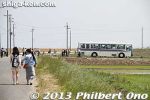
Also see kite-flying contests, exotic kites from around Japan, and stage entertainment. Anybody can fly a kite too. From 10 am to 3 pm.
|
|

Free shuttle buses ran from JR Notogawa Station to the park which had no public parking.
|
|
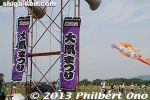
The festival name changed from Yokaichi Odako Matsuri to Higashiomi Odako Matsuri in May 2012 and the festival site changed in May 2013 to Fureai Undo Koen Park. Map
|
|
|
|
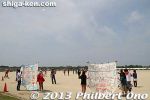
Kite-flying contest.
|
|
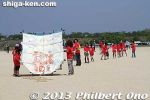
The kites are the size of two tatami mats.
|
|

About 30 teams competed in kite-flying and design contests.
|
|
|
|

Thirty teams made "mini giant kites" and competed in kite design (図柄) and flying (飛揚). They went on the outdoor stage for kite design judging.
|
|
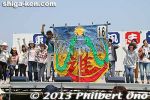
This team is from Higashi-Omi City Hall's young employees group.
|
|
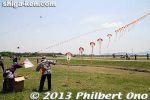
Kite trains (連凧) are the crowd favorite.
|
|
|
|
|
|
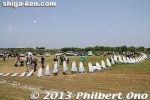
Then I stumbled across this arch kite.
|
|
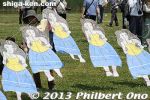
To my delight, it was an arch kite of hula girls.
|
|
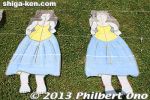
Back of the hula girls.
|
|

The hula girls were joined by Awa Odori girls from Tokushima.
|
|
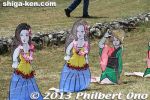
They're even wearing a lei and a flower in their hair!!
|
|
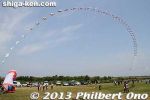
Huge arch kite of hula girls and Awa Odori dancers.
|
|
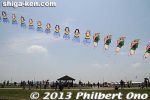
Needless to say, this was my favorite kite at the festival. How did they know someone from Hawaii was coming?
|
|
|

Their feet fluttered in the wind and their hips rocked left and right like real hula dancers.
|
|
|
|
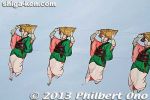
The Awa Odori dancers also danced great in the wind. (Watch my video.)
|
|
|
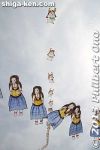
Hiko-nyan (Hikone Castle's official mascot) meets hula girls!
|
|
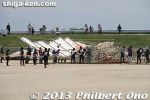
At sround 11:30 am, they cleared the area and brought out the giant kite (odako).
|
|

They were going to pull the kite across the width of the park since the way blew that way.
|
|

Made of washi paper (from Mino, Gifu) and a bamboo frame, the giant kite measures 13 meters high and 12 meters wide and weighs 700 kg.
|
|

The kite is unique for its cutout and hanjimon (判じもん) design.
|
|
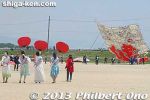
The hanjimon (判じもん) kite design always has a twin pair of creatures and a large kanji character. Together they form a thematic catch phrase.
|
|
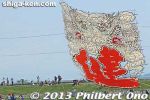
This kite's hanjimon has twin dragons that can be pronounced "shin-shin" (辰辰), a homonym for mind and body (心身). And the vermillion kanji reads "sukoyaka" (健やか), meaning good health. So the kite wishes for your "
|
|
|
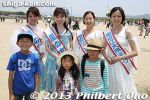
The four Wind Goddesses pose for us. The four Wind Goddesses (風の女神) are like festival princesses and they beckon the wind to blow during the kite festival.
|
|

We visit the giant kite at rest. The back of the kite has many stickers written with kids' wishes.
|
|

Higashi-Omi's giant kite is a National Intangible Folk Cultural Property (選択無形民俗文化財) with a 300-year history. It started with villages flying kites for Boy's Day in May to celebrate the birth of a boy.
|
|
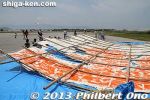
The villages then started competing in kite-making and the size grew larger and larger. The giant kite they fly today is the size of 100 tatami mats (13 m x 12 m). The Higashi-Omi Giant Kite Preservation Society (東近江大凧保存会) maintains the ki
|
|
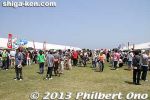
Lunch time! In the middle of the park are food booths and an entertainment stage.
|
|

The entertainment stage provided entertainment like samba dancing and taiko drummers.
|
|
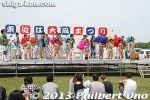
Higashi-Omi has a sizable Brazilian population.
|
|

Taiko drummers.
|
|
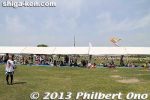
This is the first time they used this park for the festival. Closer to Lake Biwa so the wind should be stronger.
|
|

Stall selling kites. The long kite trains were sold out.
|
|

Kites for sale.
|
|
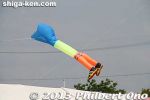
Flying trousers
|
|
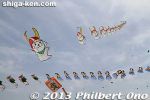
Hiko-nyan kite train and hula girl arch kite
|
|

Hiko-nyan kite train
|
|
|

Behind Hikonyan were Nagahama's Azai sister trio (Chacha, Hatsu, and Go).
|
|
|

Giant kite pullers.
|
|

Wind Goddesses fanning wind the traditional way.
|
|

Afternoon flying session from 2:30 pm to 3 pm when the festival ended.
|
|
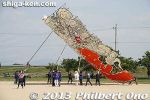
First they use long poles to prop up the giant kite.
|
|

The kite pullers get ready to run. A small taiko drum beats, faster and faster.
|
|
|
|
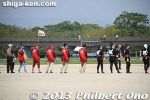
Members of the Giant Kite Preservation Society pull the front of the rope.
|
|
|
|
|
|

Around 100 people pull the giant kite. Junior high and older people can sign up to pull the kite.
|
|
|
|
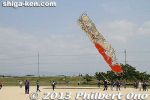
This is the last flight of several that day.
|
|
|
|
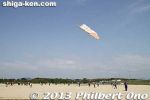
Although the kite left the ground each time, it didn't stay in the air for long.
|
|
|
|
|
|
|